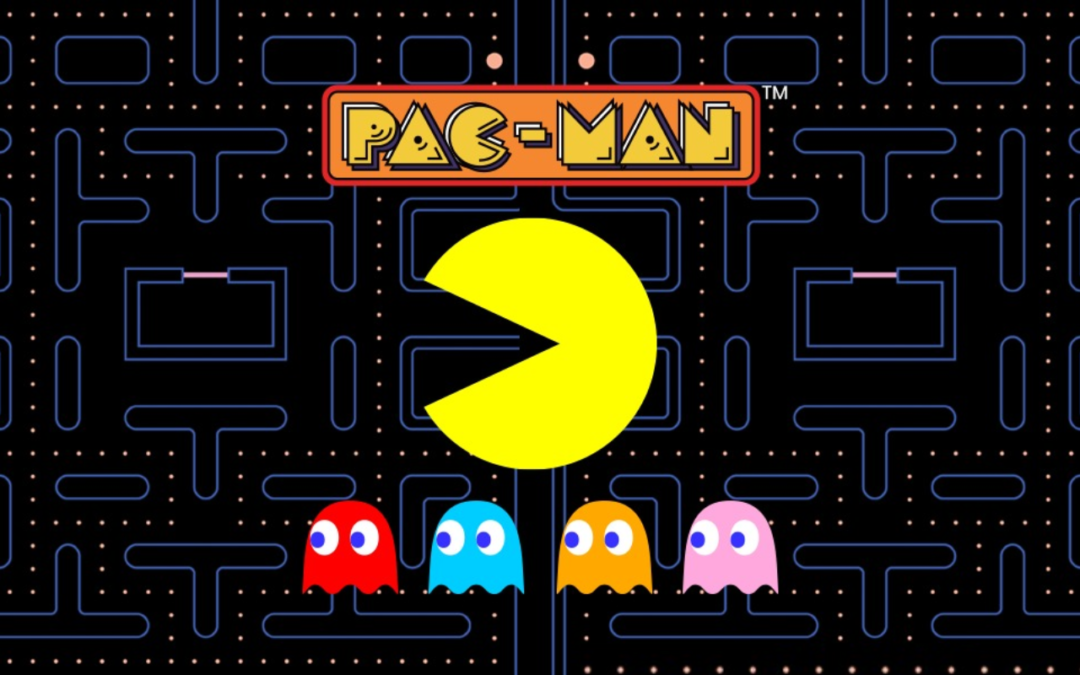lReturn of the ghostS!
This time we a have another Color Computer 3 game review – and it’s none other than Pacman. Actually, it’s a Pacman Tribute game by Nick Marentes. Nick is no stranger to my articles, having contributed information and commentary on the CoCo3 article from earlier this year. Half way thru the Donkey Kong review last month, I realized I wanted to do another well-known arcade game for the CoCo 3, and Pacman was the obvious choice, so, on with the show!
Released by Namco in Japan in May of 1980, Pacman and received a mediocre response there and was considered just another video game. However, in October of 1980, Midway licensed Pacman for release in the United States – and its success took the competition completely by surprise. The game was such a hit that it outsold all other video games, and generated more revenue Namco/Midway than Star Wars did for 20th Century Fox.
Along with the natural progression of arcade to home translations, Pacman was no different. Home versions of Pacman first appeared on the Atari 2600, Atari 8 bitters and the 5200, Commodore, Intellivsion, Apple II and many others. Atarisoft had been working on a version for the Colecovision, but, legal issues with Coleco’s Atari 2600 adapter put that on ice – though Colecovision Pacman has surfaced since the 80’s from several sources.
The Usual Suspects:
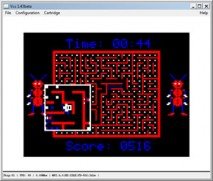
MegaBug
As with most other arcade ports to the CoCo, Tandy’s venerable little machine didn’t get an officially licensed version of Pacman. One of the first games released that seemed to be even close to Pacman was Mega Bug, written by Steve Bjork and released by Datasoft.
In Mega Bug, you navigate thru a maze eating dots, while trying to avoid the little blue creatures chasing you. When you do get caught, you hear a digitized voice saying “We got ya!” The game utilizes a magnified area of the screen that follows you around, but, it also somewhat masks the blue things chasing you. Game play wise, it is similar to Pacman, though, it’s also very different. There are no power pill power ups, nor are there any extra lives – so when the blue things get you, it’s time for a new game.
A more identifiable port was Ghost Gobbler, which is very much like the arcade in that you are a hungry semi-circle, eating dots and being chased by ghosts, and somewhat resembles the Atari 2600 version.
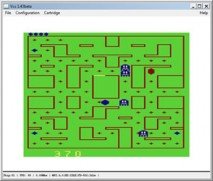
Ghost Gobbler
Due to the limited color palette of the CoCo, I doubt an arcade perfect translation is even possible. However, a game that utilized artifact colors could’ve gotten closer. The premise of Ghost Gobbler is the same as Pacman – it just looks different. After playing thru several screens, I feel safe in saying that I doubt if Ghost Gobbler has any intermission screens like the original Pacman does. The dots that Pacman consumed are replaced by plus-signs in Ghost Gobbler, and the ghosts look similar to those in Pacman, but, Ghost Gobbler himself looks more like a hexagon with a mouth than Pacman.
Speaking of an artifact color based game,the next game up is Snak-Pak from Tom Mix software. Like Ghost Gobbler above, it does it’s best to be a worthwhile clone of Pacman.
This game would not run under the VCC emulator, so I had to revert back to MESS 1.36. Yes, Snak-Pak utilizes artifact colors. While the graphics are pretty detailed with the smiling ghosts, the game play is slow and cumbersome, and the animation isn’t the smoothest around. Also, there are more power-pills on the map. I have no earthly idea if the game has any intermissions like the original Pacman since I couldn’t make myself play it long enough to find out. It should also be noted that Snak-Pak only has three ghosts on the screen.
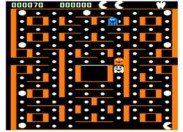
Snak-Pak
There’s more to the Snak-Pak story, though. According to L. Curtis Boyle’s CoCo Game site, there are several versions of Snak- Pak – and you can read more on it at his site. However, there appears to be no less than four versions of this game. Authoring credits are not fully known, and it seems to be the same with the distribution channels. The graphics have changed during the game’s evolution, but, the four versions are clearly the same game – you can see the different versions at Curtis’s site.
Next Please:
In consideration of the above efforts, all of the above games would be good for an honorable mention if I were handing out awards. But on the flipside of that comment, the above games were meant for play on the CoCo 1 & 2, and while they were all lacking in some aspect, they were good games for the CoCo 1 & 2 lines. Besides, I’m not handing out awards, and there were a
couple other Pacman clones that just weren’t very good or entertaining enough to discuss in this article. Unlike what ‘The King’ did for Donkey Kong, there doesn’t appear to be a standout Pacman clone for the CoCo 1 & 2.
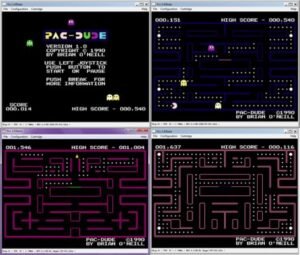
Pacdude
Pacdude differs from Pacman in that there are multiple mazes during the game – so I guess you could say that Pacdude is similar to not only Pacman but also Ms. Pacman. Additionally, during my time spent playing Pacdude, I can say that the keyboard
controls are quite frustrating – almost maddening. Graphics and sound wise, Pacdude comes in at number 2 for the CoCo 3. While the sounds are not true to the arcade, they seem to fit pretty well to the game. Like the rest of the games mentioned earlier, Pacdude is missing the in-game intermissions, but it is still a very good attempt at a Pacman clone.
Will the REAL Pac-Man Please Come Forward:
That brings us to Nick Marente’s Pacman Tribute game. Nick has authored some very cool games for the TRS-80 Model I/III computers, as well as the original TRS-80 Color Computer: Donut Dilemma, Rupert Rythym and Neurtroid 2 to name a few.
For the CoCo3, Nick also created Space Intruders and Cosmic Ambush – two of the very best games of their genre.
In 1997, after five years away from CoCo programming, Nick decided to create a new game for the CoCo 3. Not wanting to do the CoCo 3, Pacman or Namco any injustices at all, Nick set out to make a Pacman version for the CoCo 3 that looked, sounded and played as close as possible to the beloved arcade classic. Nick hand drew the graphics on his Amiga 1200 and used digitized recordings of an actual Pacman game for the sound effects. The results are quite impressive.
Nick:
“I developed Pacman before I had any MAME arcade emulator for my PC which would have made it easier to translate the graphics and sound. Instead, I had a friend who actually owned a real sitdown Pacman arcade machine and we would play it over and over, examining the ghosts AI movements and the flow of the game. Based on these observations, I formulated an AI algorithym that tried to mimick the original ghost AI.
The way this worked was to setup 5 target points on the screen. One in each of the four corners of the maze plus another in the centre. Each ghost was assigned one of these targets and the ghosts would attempt to navigate towards their respective targets.
After a time, the targets were rotated amongst the ghosts and this prevented the ghosts from getting stuck in one area of the maze and have them travel the entire area of the maze in search of the Pacman.
When the X or Y position of the ghosts coincided with the Pacman characters X and Y, the target was changed to the position of the Pacman and the ghost would attempt a course change to zero in on that new target.
If the target was not reached in a set time, the ghosts reverted to the original targeting system. A simple idea that worked uncannily similar to the arcade.
Many years later, I located a document on the internet that explained the actual arcade game AI and I was amazed to find that it to used a similar targeting system, although extended in ways to provide each ghost with a few extra variations.”

On the left is the loading screen – many CoCo games didn’t have a loading screen so all you got was a blank screen while the disk drive spun away. The middle screen is the game setup screen where you can tailor the game to the CoCo3 system you are running Pacman on. On the right is the title screen.
Nick:
“In order to translate the original arcade sound effects, I actually sat with a cassette recorder and microphone near the cabinet’s speaker and recorded all the actual sounds.
I used the CoCo3 running Studio Works to sample the sound effects directly into the CoCo and edited these files into my game.”
Gameplay:
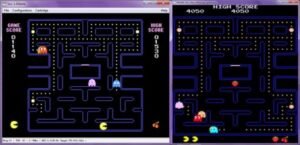
Above left is Nick’s Pacman Tribute level one screen. When compared to the original Pacman running on MAME in the right image (yes, that’s level two), the game looks very close to the arcade hit. There are differences in color (due to the CoCo3’s color palette limitations) and resolution, but, Nick did a tremendous job with his port to the CoCo3.
Nick:
“The game graphics was created by hand using Brilliance 2.0 on a Commodore Amiga 1200 based on my observations of the real machine. I also found various screenshots on the internet that I was able to refer to in order to recreate the graphics to suit the CoCo3’s 320×225 resolution.
The original arcade machine used a resolution of 224 x 288. It was essentially a normal screen as on the CoCo but tipped sideways to utilize the wider direction as the vertical. Since tipping the CoCo screen on it’s side was impractical, I had to compensate by moving the score display area to the sides of the screen, optimising the screen height for the maze.”
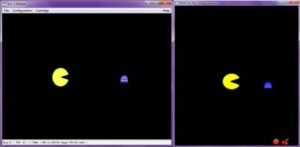
Nick has stated that the CoCo3 Pacman Tribute game contains all of the original game’s intermission shots as well. Even though I enjoyed playing it, I was never really good at Pacman, being able to only get thru about 20 levels back in the day. While I didn’t have that kind of time to put into the game play for this article, I can confirm that at least the first intermission is present. Again,
the CoCo3 Pacman is on the left, MAME on the right. The in game sound effects and music are there. Some of the effects appear to play a little slower on the CoCo 3 version, and are at a reduced sampling rate, but, I’ve noticed the same on other platforms as well – and that’s without discussing the Atari 2600 version.
Nick:
“Pacman has been my best private selling game that didn’t have the benefit of being sold by a distributor such as Tandy/Radio Shack. All sales were directly from me and most sales were made at the Pennfest 1999 Color Computer festival hosted by Ron Bull.”
Game Over Man!!
When compared to some of the other Pacman versions that have appeared on other systems over the years, much like Sockmaster’s Donkey Kong, the CoCo3 version by Nick Marentes stands up proudly. It may not be an arcade perfect translation, but, it’s VERY close. Nick easily met his goal of creating a game that was as close to the arcade as possible, and indeed did the CoCo3, Pacman and Namco all the justice they deserved.
This article first appeared in the now defunct ‘Retrogaming Times Monthly’ online magazine in 2013.

